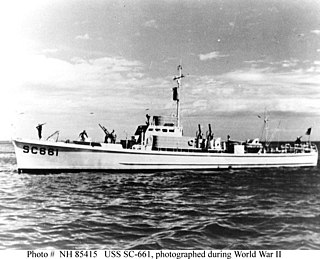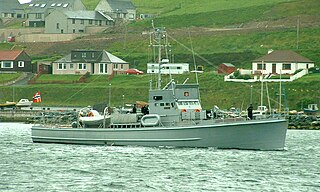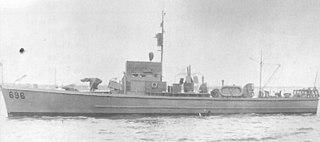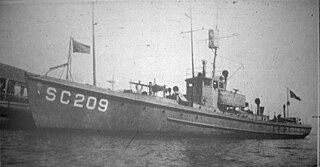
A submarine chaser or subchaser is a small naval vessel that is specifically intended for anti-submarine warfare. Many of the American submarine chasers used in World War I found their way to Allied nations by way of Lend-Lease in World War II.

The Shetland Bus was the nickname of a clandestine special operations group that made a permanent link between Mainland Shetland in Scotland and German-occupied Norway from 1941 until the surrender of Nazi Germany on 8 May 1945. From mid-1942, the group's official name was the Norwegian Naval Independent Unit (NNIU). In October 1943, it became an official part of the Royal Norwegian Navy and was renamed the Royal Norwegian Naval Special Unit (RNNSU). The unit was operated initially by a large number of small fishing boats and later augmented by three fast and well-armed submarine chasers – Vigra, Hessa and Hitra.

HNoMS Draug was the lead ship of the three-ship Draug class of destroyers built for the Royal Norwegian Navy in the years 1908–1913. The four-stacked destroyer was kept in service long after she was obsolete, and took part in the defence of Norway during the German invasion in 1940.
The Shetland bus was the name given to a clandestine special operations group that made a permanent link between Shetland, Scotland, and German-occupied Norway. From mid-1941 until the end of the war it operated a number of vessels, mostly Norwegian fishing boats.

The SC-497-class submarine chasers were a class of 438 submarine chasers built primarily for the United States Navy from 1941–1944. The SC-497s were based on the experimental submarine chaser, USS SC-453. Submarine chasers of this variety were collectively nicknamed "the splinter fleet" due to their wooden hulls.

USS SC-500 was a United States Navy SC-497-class submarine chaser in commission from 1942 to 1945 during World War II. She later served in the Soviet Navy as BO-319.

The SC-1 class was a large class of submarine chasers built during World War I for the United States Navy. They were ordered in very large numbers in order to combat attacks by German U-boats, with 442 boats built from 1917 to 1919.
The Japanese submarine chaser CH-24 was a No.13-class submarine chaser of the Imperial Japanese Navy during World War II. She was built by the Ōsaka Iron Works, Sakurajima and completed on 20 December 1941. On 24 August 1942, she left Rabaul as part of Operation RE, for the landings at Milne Bay. On March 15, 1943 she, along with CH-22 and Satsuki, sank a submarine, possibly USS Triton, north west of the Admiralty Islands.

The HNoMS Vigra was a Royal Norwegian Navy submarine chaser that saw action during World War II. She was named after the Norwegian island of Vigra.

The HNoMS Hessa was a Royal Norwegian Navy submarine chaser that saw action during World War II. She was named after the Norwegian island of Hessa.

USS SC-744 was an SC-497-Class submarine chaser of the United States Navy during World War II. She was sunk by a Japanese Kamikaze in 1944.

USS SC-209, prior to July 1920, known as USS Submarine Chaser No. 209 or USS S.C. 209, was an SC-1-class submarine chaser in commission in the United States Navy during 1918. She was the victim of the deadliest friendly fire incident involving the U.S. Navy during World War I.
USS SC-95, prior to July 1920 known as USS Submarine Chaser No. 95 or USS S.C. 95, was an SC-1-class submarine chaser built for the United States Navy during World War I. She operated as part of the Otranto Barrage during the war. Postwar, she saw service in the Adriatic Sea, in North Russia, and in the clearance of the North Sea Mine Barrage. After her U.S. Navy service, she became a private motor yacht.
USS SC-151, prior to July 1920 known as USS Submarine Chaser No. 151 or USS S.C. 151, was an SC-1-class submarine chaser built for the United States Navy during World War I. She operated as part of the Otranto Barrage during the war.

USS SC-227, prior to July 1920 known as USS Submarine Chaser No. 227 or USS S.C. 227, was an SC-1-class submarine chaser built for the United States Navy during World War I. She operated as part of the Otranto Barrage during the war.











